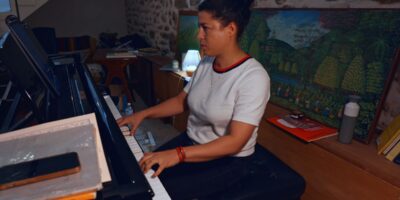Several reports place Haiti at the top of the list of modern “slave-owning” countries. The designation is not unanimously accepted by experts.
François is 13 years old. Originally from Les Cayes, she lives in Carrefour-Feuilles and attends the Lycée National Calystène Fouchard. The young child, who is in her 5th year of basic education, has been living with an aunt for the past four years.
Her mother, who stayed in Les Cayes to take care of her other children, almost never comes to see her. As for her father, he left some time ago to settle in the Dominican Republic, and François has no news of him.
At the age of 13, she is responsible for most of the housekeeping, going to the market, cooking, and washing dishes in the house where she lives with four other people: her aunt, her aunt’s husband, and their two children.
François is a restavèk child. The practice likened by some to slavery.
“The two situations are similar, » explains historian and university professor Derynx Petit-Jean. “One exploits the labor of another, in this case, the child, and is not compensated in return similar to a slaves condition, which is not a salaried condition.”
These children, for the most part, are not only physically abused, but they are also under-educated and under-nourished.
According to the historian, this situation mimics what was done during the colonial period, as it divides the family and affects the future of the child “restavèk.”
“They do not benefit from their rights, such as eating from the meals they have prepared, sleeping when they want, etc., explains Derynx Petit-Jean. It is the survival in Haitian society of slavery practices inherited from colonization.”
Marie Rosie Auguste, program manager at RNDDH disagrees. For her, the contract is different between these two forms of exploitation: in cases of slavery, the well-being of the individual is not a priority.
“The host family is committed to providing better living conditions for the child, argues Auguste. It is in the application of this contract that a given family turns out to be a bad alternative for the parents and the children in care.”
For the human rights advocate, comparing the two forms of exploitation is to minimize the trauma of slavery, though the domesticity of children is equally condemnable.
Moreover, before the revolution of 1804, the condition of a slave generally followed the person all of their life and could also affect his progeny. The same is not true for the restavèk.
The International Labour Organization (ILO) condemns the practice, which deprives victims of their childhood, their dignity, while affecting their academic performance. In 2006, the ILO estimated the number of children in domestic service in Haiti at 250,000, while a 2013 study by the United Nations Stabilization Mission in Haiti estimated them at between 150,000 and 500,000.
According to a 2018 Global Slavery Index report, there are 40.3 million people living in slavery conditions in the modern world. Venezuela, Haiti, and the Dominican Republic have the most disturbing prevalences in the Americas.
Some people think that this practice is less common nowadays. This is not the case. According to Marie Rosie Auguste, this impression comes from the fact that the name has changed. It is now called foster care.
Girls are the most likely to find themselves in conditions of domestic service. According to Marie Rosie Auguste, many of them are raped or harassed by men in the home: “In foster families where there is a young boy, it is tolerated, and sometimes even encouraged, that the young man has his first sexual experiences with the child in domestic care.”
A smaller number of boys are also subjected to these and other abuses.
According to Jeff Odiesse, a lawyer at the Mirebalais court and human rights activist, a decree prohibiting all forms of abuse, violence, mistreatment, or inhumane treatment against children was published in the Moniteur on April 29, 2003. Almost twenty years later, nothing has changed for these children.
This decree does not sufficiently consider the aspect of domestic work for victims nor the social conditions that create this practice in the country.
“At one time, there was a police phone line for reporting abuse. The line received some calls, but on the few occasions they’ve gone to court, the domesticity aspect was always missing. It was more the abuse,” laments Marie Rosie Auguste.
In addition, there are almost never any trials for the few cases of complaints against foster families, which affirms them in this practice, says Odiesse.
The social aspect is important and according to Marie Rosie Auguste, it should also be taken into account by the government in its fight against the practice of restavèk in Haiti.
“Precariousness is a key factor that explains why parents place their children with relatives or strangers. A new profession has even emerged: people who specialize in finding children for placement, like real estate agents.”
Despite the disappointing number of prosecutions in cases regarding children in domestic service, Odiesse says there are several laws in Haitian law to protect children. But a poor country like Haiti, with limited resources, can hardly enforce them.
For this reason, the lawyer and the RNDDH program manager proposes a two-pronged solution. First, an effort to address social issues: most children are placed in domestic care because their parents do not have the means to care for them.
Second, it is necessary to facilitate legal remedies for abused children because the impunity for perpetrators continues to perpetuate the restavèk.
English translation by Didenique Jocelyn and Sarah Jean.







Comments